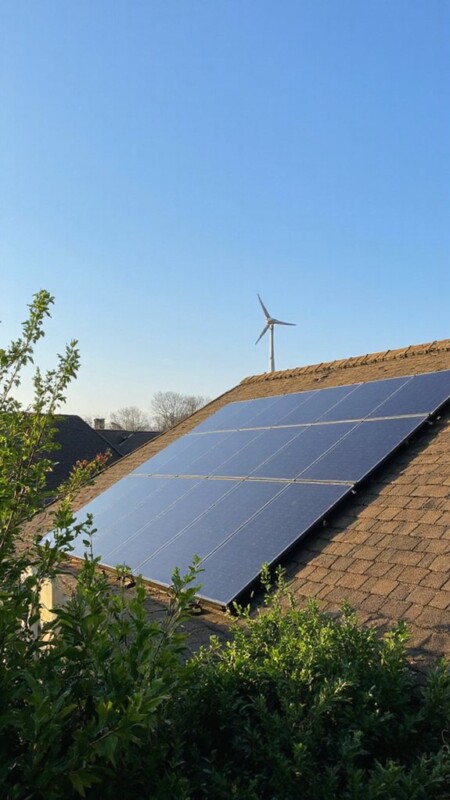You’ll get better value and reliability from solar panels than wind turbines for your home. Solar costs less upfront, pays off faster, and needs almost no maintenance, while wind turbines are pricier and have more downtime.
Solar fits on rooftops, stays quiet, and blends into neighborhoods with minimal visual impact. You can expand your system easily, too.
These advantages explain why solar is often the top choice; let’s break down each factor in detail.
Key Takeaways
- Solar panels have lower upfront costs and faster payback periods compared to wind turbines, making them more affordable for most homeowners.
- Installation of solar panels is quick, minimally invasive, and suitable for rooftops, unlike wind turbines which require significant open space.
- Solar panels operate silently and blend aesthetically with homes, while wind turbines are noisy and visually obtrusive.
- Maintenance for solar panels is minimal due to no moving parts, whereas wind turbines need frequent and complex servicing.
- Solar systems are easily scalable and flexible in placement, offering more options than the site-restricted requirements of wind turbines.
Residential Suitability and Practicality
When considering which renewable energy system best fits residential properties, how do solar panels and wind turbines compare in terms of practical installation and everyday usability?
Solar panels offer superior installation efficiency for most homes, utilizing existing roof space—typically 20-30 square meters for a 4kW system—without requiring significant landscape alteration.
Solar panels maximize roof space, delivering efficient energy for homes without altering the landscape or requiring extensive installations.
They’re nearly silent, integrate seamlessly into rooftops or ground mounts, and face fewer zoning hurdles. Their energy yield remains consistent and predictable during daylight hours, even on cloudy days, thanks to stable solar irradiance.
In contrast, wind turbines require substantial open space, free from turbulence, and often need tall towers and concrete foundations.
Their energy yield is highly dependent on local wind patterns, making output less reliable. Wind turbines also generate noise and demand regular, complex maintenance.
Cost-Effectiveness for Homeowners
Although both solar panels and wind turbines offer pathways to energy independence, solar panels consistently deliver superior cost-effectiveness for residential settings. When you perform a cost comparison, solar’s initial investment is generally lower—about £7,860 in the UK or $8,500–$21,600 in the US before economic incentives. Residential wind turbines, in contrast, often require higher upfront spending for equivalent energy output. Operational costs further favor solar, with minimal ongoing expenses compared to the regular maintenance wind turbines demand. Payback periods for solar typically range from 2–10 years, substantially shorter than the 10–30 years common with home wind systems.
| System | Typical Upfront Cost | Payback Period |
|---|---|---|
| Solar Panel | $8,500–$21,600 | 2–10 years |
| Wind Turbine | $11,000–$41,500 | 10–30 years |
| Incentives | Up to 30% off | — |
Maintenance and Reliability Considerations
Given their distinct engineering, solar panels and wind turbines present particularly different maintenance and reliability profiles.
If you prioritize maintenance simplicity, solar panels stand out—they have no moving parts, so wear and tear is minimal. Routine care involves occasional cleaning and inverter replacement every 10–15 years. Their robust design offers operational reliability, with typical lifespans reaching 25–30 years and warranties often covering 25 years of output.
Wind turbines, by contrast, demand more frequent and complex maintenance. Their moving components—blades, gearboxes, and bearings—require regular inspections, lubrication, and part replacements, increasing costs and downtime.
Wind turbines require frequent maintenance, as their moving parts need inspections, lubrication, and replacements—leading to higher costs and downtime.
Specialized technicians are often needed, especially for offshore repairs. Turbine output is also less predictable, relying on variable wind conditions, and mechanical failures are more common, reducing general operational reliability.
Flexibility and Scalability of Installation
A wide range of installation scenarios reveals clear differences in flexibility and scalability between solar panels and wind turbines.
If you’re seeking installation versatility, solar panels offer broad applicability—adapting to rooftops, walls, carports, and ground mounts, especially in urban and suburban settings where space is limited.
Wind turbines, however, require open areas with consistent wind, often restricting them to rural or coastal locations.
Solar’s modular design enables you to scale system size precisely, from a few panels for a home to vast utility-scale arrays.
Consider these technical distinctions:
- Solar panels integrate easily with existing structures.
- Wind turbines need significant open space and distance from obstacles.
- Solar’s modularity simplifies future capacity increases.
- Wind projects demand complex planning and foundational work.
- Residential solar installation is typically faster and less invasive.
Noise and Visual Impact in Neighborhoods
Beyond flexibility and scalability, the real-world impact of solar panels and wind turbines in neighborhoods often comes down to noise and visual presence.
You’ll find that solar panels generate zero operational noise—no moving parts mean no noise pollution, aside from minimal inverter hum that’s typically undetectable. Their low profile and options for color-matching or solar shingles allow for strong aesthetic integration with existing buildings, making them neighborhood-friendly.
In contrast, wind turbines produce both mechanical and aerodynamic noise, with base levels reaching 60 dB—similar to normal conversation—potentially causing annoyance even below regulatory limits.
Visually, turbines stand out due to their height and rotating blades, often altering landscape character. These factors frequently drive community preference toward solar, given its lower noise and visual impact.
Localized Environmental Effects
While both solar panels and wind turbines generate clean energy, they produce distinct localized environmental effects that shape their suitability for different landscapes. You’ll want to weigh these impacts carefully, especially regarding habitat alteration and wildlife impact.
Solar farms often lead to direct land conversion and fragmentation, affecting ground-nesting birds and small mammals. Wind turbines, on the other hand, allow continued agriculture but pose direct collision risks to birds and bats. Both technologies also influence microclimates and soil conditions.
- Solar farms intensively use land, causing more habitat alteration per megawatt than wind farms.
- Wind turbines increase bird and bat mortality, especially along migratory routes.
- Solar panels can alter plant communities and reduce light/temperature beneath arrays.
- Soil compaction and erosion risks are higher during solar farm construction.
- Wind farms maintain agricultural productivity on most of their footprint.
Conclusion
When you evaluate energy solutions for your home, solar panels typically offer greater practicality and cost-effectiveness than wind turbines.
Their lower maintenance needs, scalable installation options, and minimal noise or visual disruption make them ideal for residential environments.
Data shows solar panels outperform home-scale wind systems in reliability and energy yield across most regions.
By choosing solar, you’ll enhance efficiency and minimize localized environmental impact, making it the smarter, data-backed investment for homeowners seeking renewable energy.



